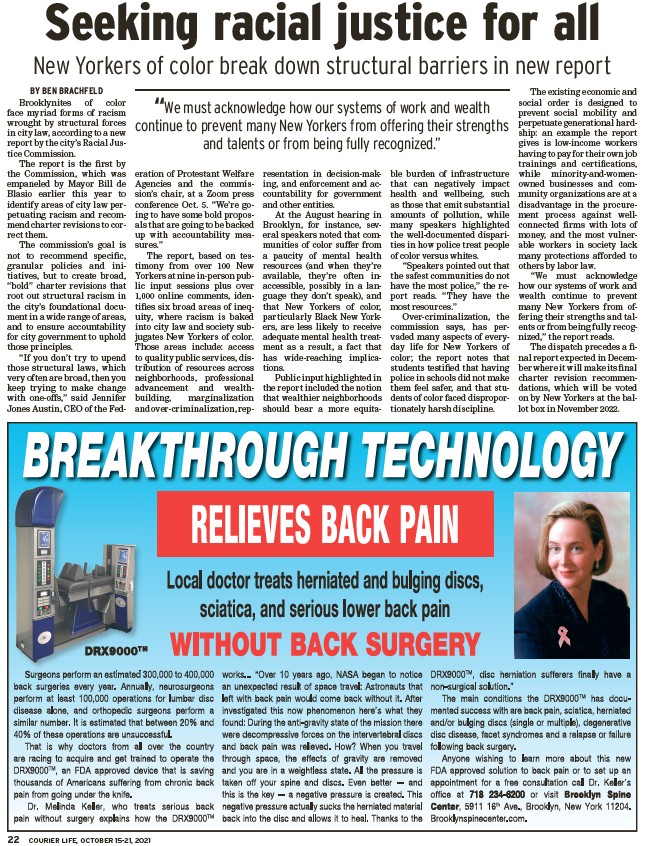
Seeking racial justice for all
New Yorkers of color break down structural barriers in new report
BY BEN BRACHFELD
Brooklynites of color
face myriad forms of racism
wrought by structural forces
in city law, according to a new
report by the city’s Racial Justice
Commission.
The report is the fi rst by
the Commission, which was
empaneled by Mayor Bill de
Blasio earlier this year to
identify areas of city law perpetuating
racism and recommend
charter revisions to correct
them.
The commission’s goal is
not to recommend specifi c,
granular policies and initiatives,
but to create broad,
“bold” charter revisions that
root out structural racism in
the city’s foundational document
in a wide range of areas,
and to ensure accountability
for city government to uphold
those principles.
“If you don’t try to upend
those structural laws, which
very often are broad, then you
keep trying to make change
with one-offs,” said Jennifer
Jones Austin, CEO of the Federation
COURIER L 22 IFE, OCTOBER 15-21, 2021
of Protestant Welfare
Agencies and the commission’s
chair, at a Zoom press
conference Oct. 5. “We’re going
to have some bold proposals
that are going to be backed
up with accountability measures.”
The report, based on testimony
from over 100 New
Yorkers at nine in-person public
input sessions plus over
1,000 online comments, identifi
es six broad areas of inequity,
where racism is baked
into city law and society subjugates
New Yorkers of color.
Those areas include: access
to quality public services, distribution
of resources across
neighborhoods, professional
advancement and wealthbuilding,
marginalization
and over-criminalization, representation
in decision-making,
and enforcement and accountability
for government
and other entities.
At the August hearing in
Brooklyn, for instance, several
speakers noted that communities
of color suffer from
a paucity of mental health
resources (and when they’re
available, they’re often inaccessible,
possibly in a language
they don’t speak), and
that New Yorkers of color,
particularly Black New Yorkers,
are less likely to receive
adequate mental health treatment
as a result, a fact that
has wide-reaching implications.
Public input highlighted in
the report included the notion
that wealthier neighborhoods
should bear a more equitable
burden of infrastructure
that can negatively impact
health and wellbeing, such
as those that emit substantial
amounts of pollution, while
many speakers highlighted
the well-documented disparities
in how police treat people
of color versus whites.
“Speakers pointed out that
the safest communities do not
have the most police,” the report
reads. “They have the
most resources.”
Over-criminalization, the
commission says, has pervaded
many aspects of everyday
life for New Yorkers of
color; the report notes that
students testifi ed that having
police in schools did not make
them feel safer, and that students
of color faced disproportionately
harsh discipline.
The existing economic and
social order is designed to
prevent social mobility and
perpetuate generational hardship:
an example the report
gives is low-income workers
having to pay for their own job
trainings and certifi cations,
while minority-and-womenowned
businesses and community
organizations are at a
disadvantage in the procurement
process against wellconnected
fi rms with lots of
money, and the most vulnerable
workers in society lack
many protections afforded to
others by labor law.
“We must acknowledge
how our systems of work and
wealth continue to prevent
many New Yorkers from offering
their strengths and talents
or from being fully recognized,”
the report reads.
The dispatch precedes a fi -
nal report expected in December
where it will make its fi nal
charter revision recommendations,
which will be voted
on by New Yorkers at the ballot
box in November 2022.
“We must acknowledge how our systems of work and wealth
continue to prevent many New Yorkers from offering their strengths
and talents or from being fully recognized.”